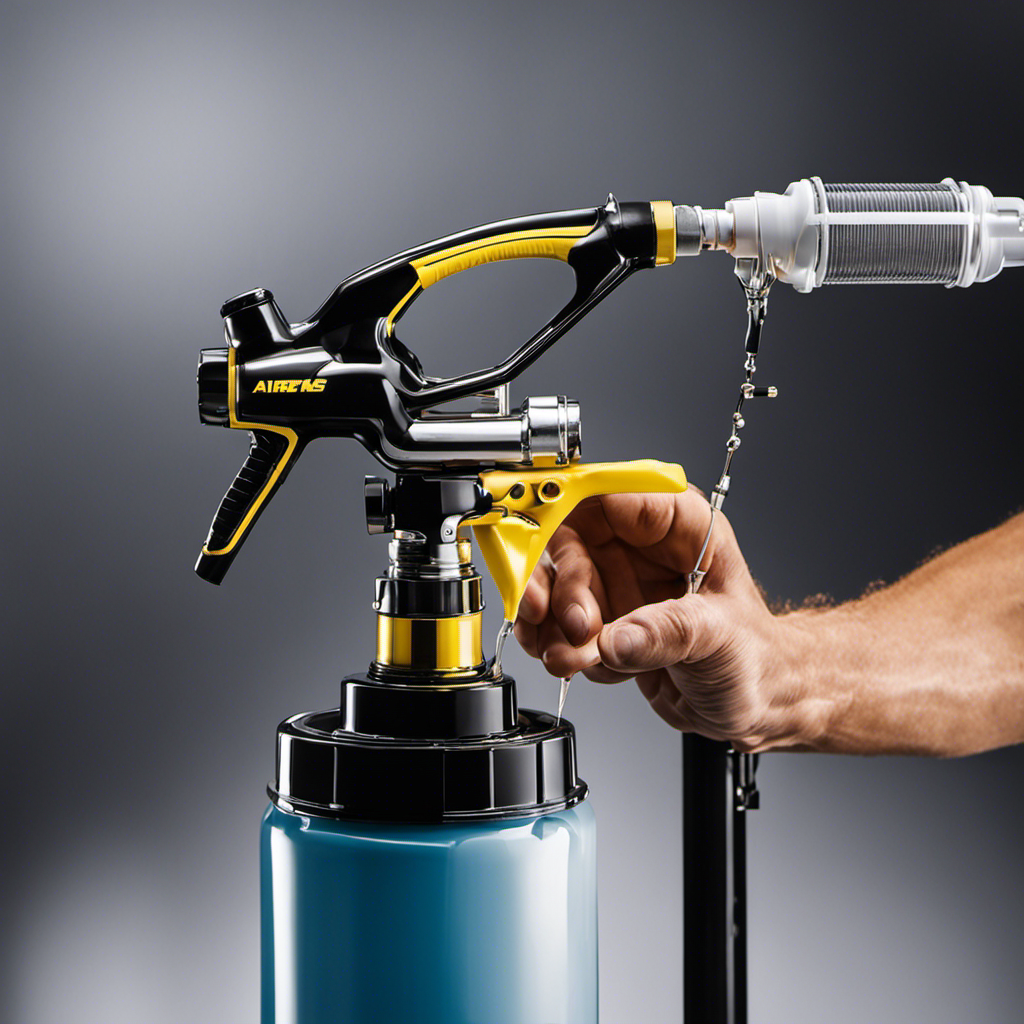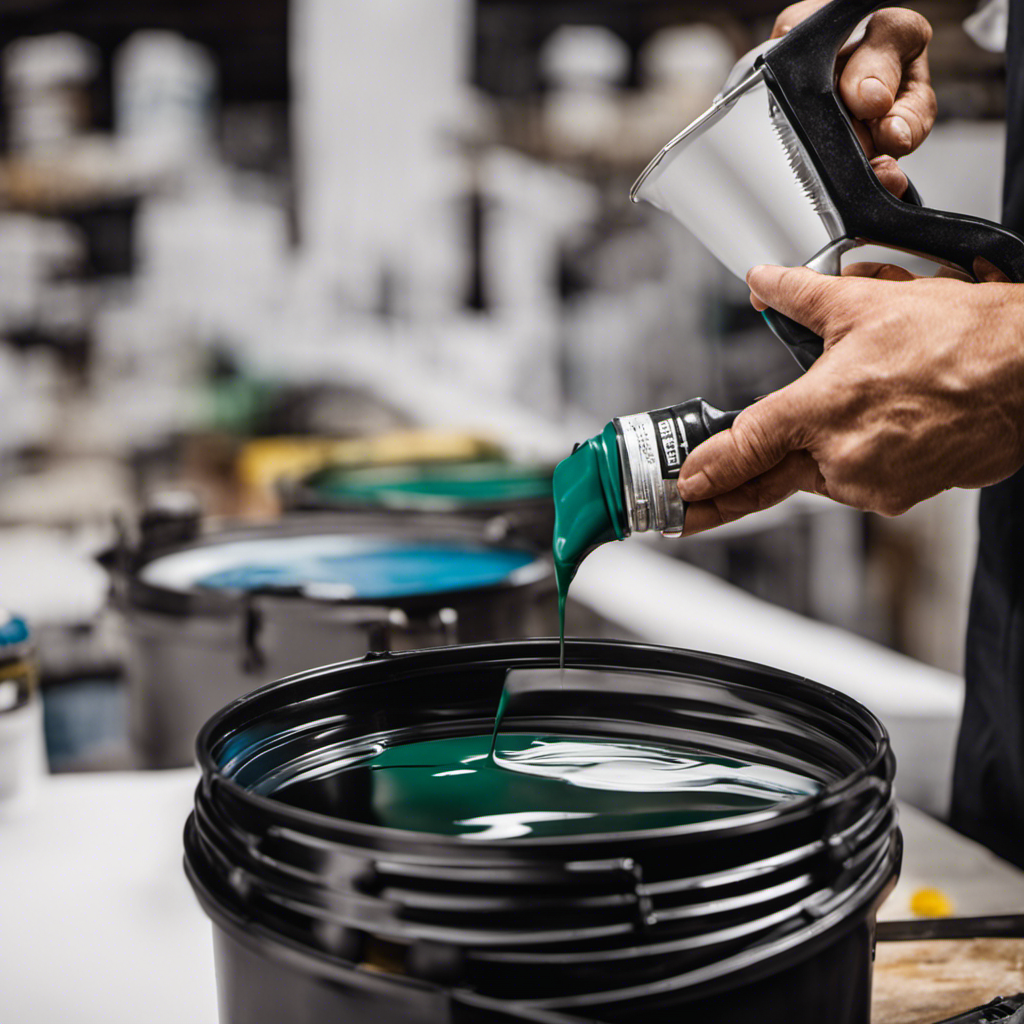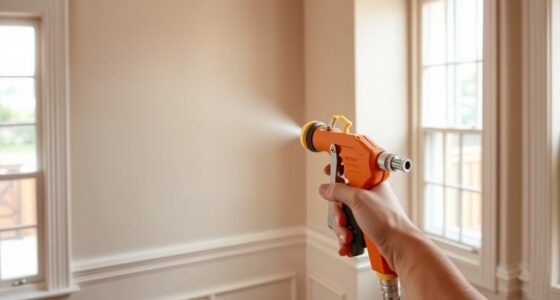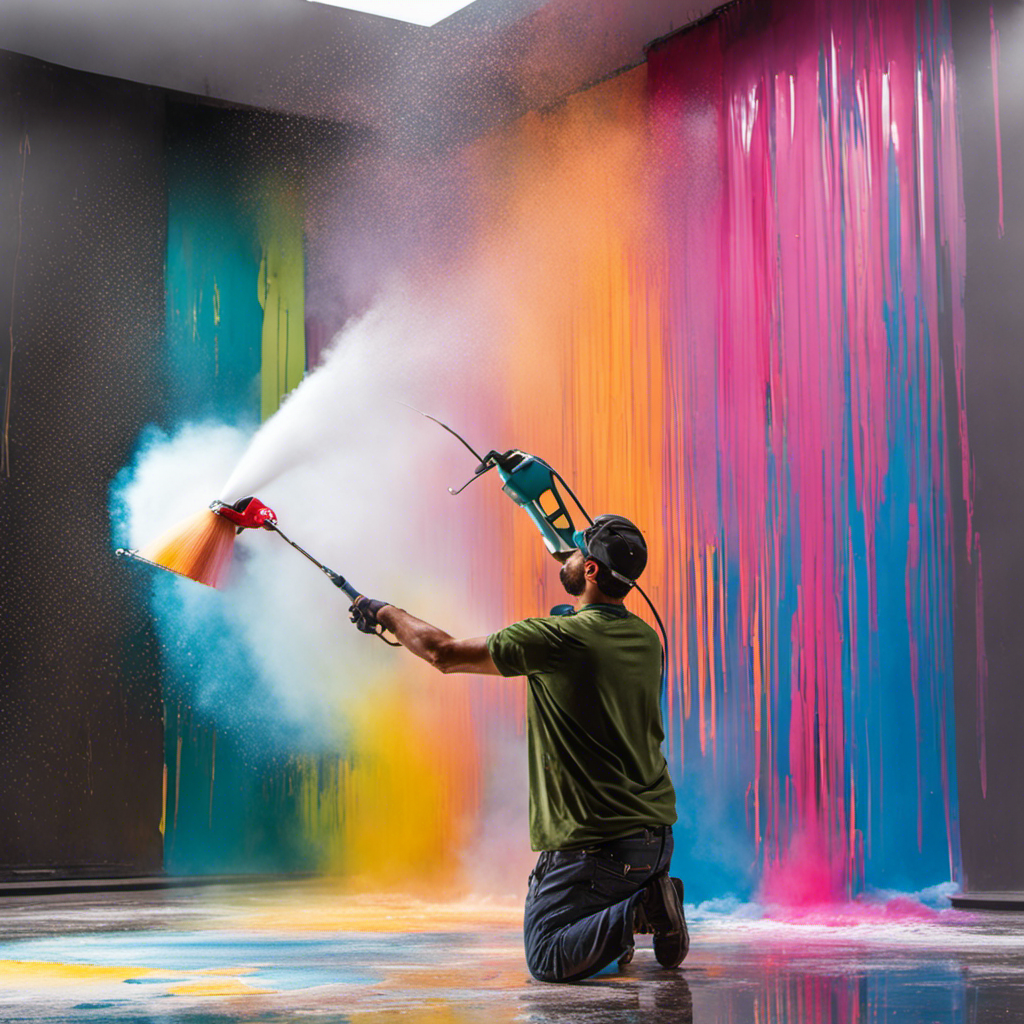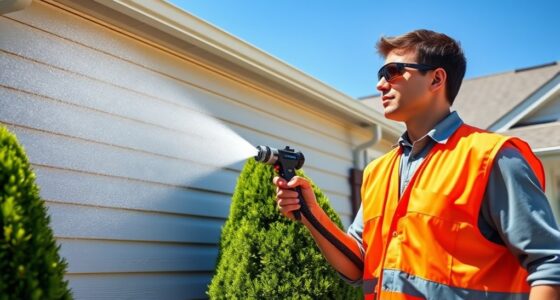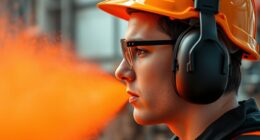Ensuring that your airless paint sprayer has sufficient oil is essential for maximizing its performance and extending its lifespan. By maintaining proper oil levels and conducting regular inspections, you can keep your sprayer in top condition, reducing the risk of malfunctions and saving money on potential repairs.
High-quality lubricants are recommended as they reduce wear and tear and help maintain consistent pressure and flow for a professional paint finish. Pump lubrication also saves time and money in the long run.
There are various types of lubricants available for Campbell Hausfeld airless paint sprayers, including silicone, Teflon, mineral oil, synthetic lubricants, and specialty pump lubricants. It’s important to follow the manufacturer’s instructions for regular pump lubrication and to monitor the oil level to prevent dry running of the pump.
Troubleshooting common pump lubrication problems and proper maintenance techniques, such as cleaning the pump filter and inspecting hoses for wear or damage, can extend the lifespan of the paint sprayer.
Key Takeaways
- Proper lubrication is crucial for optimal performance and longevity of airless paint sprayers.
- Regular maintenance, including pump lubrication, is necessary to keep the sprayer in top condition.
- High-quality lubricants help reduce wear and tear, preventing breakdowns and costly repairs.
- Lubrication maintains consistent pressure and flow, resulting in a professional paint finish.
The Benefits of Proper Pump Lubrication
Properly lubricating the pump with high-quality lubricants reduces wear and tear, preventing breakdowns and costly repairs. Inadequate pump lubrication can have several drawbacks, including increased friction, overheating, and premature wear of the pump components.
Insufficient lubrication can also lead to decreased performance and inconsistent pressure and flow, resulting in an inferior paint finish. To troubleshoot common pump lubrication problems, it is important to check the lubrication level and ensure it is within the recommended range.
Using the correct lubricant specified by the manufacturer and applying it correctly, following the user manual instructions, is crucial. In case of inadequate lubrication, improper application, or the use of the wrong lubricant, prompt action should be taken to address the issue.
The Role of Regular Maintenance in Pump Performance
Regularly maintaining the pump is crucial for ensuring optimal performance and extending its lifespan. Neglecting pump lubrication can have a significant impact on paint sprayer efficiency. Here are three reasons why scheduling regular maintenance is important for pump performance:
-
Prevents breakdowns: Regular pump lubrication reduces wear and tear, preventing breakdowns and costly repairs. High-quality lubricants provide the necessary protection against friction and corrosion, ensuring smooth operation.
-
Maintains consistent pressure and flow: Lubrication helps maintain consistent pressure and flow, resulting in a professional paint finish. Without proper lubrication, the pump may experience fluctuations in pressure and flow, leading to uneven application and unsatisfactory results.
-
Saves time and money: By regularly maintaining the pump and ensuring proper lubrication, you can save time and money in the long run. A well-maintained pump performs efficiently, reducing the risk of downtime and the need for expensive repairs.
To maximize the performance and lifespan of your airless paint sprayer, make sure to schedule regular maintenance and prioritize pump lubrication. Neglecting this crucial aspect can have a significant impact on the efficiency and effectiveness of your paint sprayer.
The Importance of High-Quality Lubricants for Airless Paint Sprayers
Using high-quality lubricants is essential for ensuring optimal performance and longevity of airless paint sprayers. The role of lubrication in preventing breakdowns cannot be overstated. Regular maintenance, including pump lubrication, is crucial to keep the sprayer in top condition.
High-quality lubricants reduce wear and tear, preventing costly repairs. Additionally, lubrication plays a significant role in the quality of the paint finish. It helps maintain consistent pressure and flow, resulting in a professional and smooth finish. By properly lubricating the pump, painters can save time and money in the long run.
It is important to choose the right lubricant for the specific airless paint sprayer model and to follow the manufacturer’s instructions for regular pump lubrication. Neglecting proper lubrication can lead to inefficiency, rust, and corrosion, compromising the performance and lifespan of the sprayer.
Achieving Consistent Pressure and Flow With Lubrication
To achieve consistent pressure and flow, painters can rely on the lubrication of the pump in their airless paint sprayers. This crucial step prevents pump damage and ensures smooth operation. Here are three key tips for troubleshooting lubrication issues:
-
Check the lubrication level: Regularly monitor the oil level and ensure it is within the recommended range. Refill as needed to prevent dry running of the pump.
-
Use the correct lubricant: Follow the manufacturer’s instructions and use the lubricant specified for your airless paint sprayer. Using the wrong lubricant can lead to inadequate lubrication and potential damage.
-
Proper application: Apply the lubricant correctly, following the user manual instructions. Improper application can result in inefficiency and potential breakdowns.
Saving Time and Money With Proper Pump Lubrication
Applying the recommended lubricant to the pump of an airless paint sprayer helps professionals save time and money in the long run. Inadequate pump lubrication can have a significant impact on paint quality, leading to uneven application and a poor finish. Troubleshooting common pump lubrication problems is essential for maintaining optimal performance.
Here are some common pump lubrication problems and their solutions:
| Problem | Solution |
|---|---|
| Insufficient lubrication | Check lubrication level and refill as needed. |
| Improper lubricant application | Use the correct lubricant specified by the manufacturer and apply it correctly. |
| Use of the wrong lubricant | Use the lubricant recommended by the manufacturer. |
Exploring Different Types of Lubricants for Airless Paint Sprayers
Silicone lubricant provides excellent protection against corrosion and offers superior lubrication for optimal performance and longevity. When exploring alternative lubricants for airless paint sprayers, it is important to consider the pros and cons of different options.
Here are three key factors to consider:
-
Effectiveness: Silicone lubricant is known for its excellent lubrication properties, ensuring smooth operation and preventing friction-related issues. It also provides a protective barrier against corrosion, extending the lifespan of the pump.
-
Compatibility: Different lubricants may have varying compatibility with different materials. It is crucial to choose a lubricant that is suitable for the specific airless paint sprayer model and the materials being used.
-
Environmental Impact: Some lubricants may have a higher environmental impact than others. It is important to choose lubricants that are environmentally friendly and safe for use.
The Advantages of Silicone Lubricant for Pump Protection
Using silicone lubricant for pump protection offers several advantages. It has superior corrosion resistance and provides optimal lubrication for extended pump lifespan. Silicone lubricant has a higher resistance to harsh chemicals and moisture compared to other lubricants. This makes it highly effective in preventing corrosion and rust. Additionally, it provides exceptional lubrication properties, reducing friction and wear on pump components. This ultimately extends the pump’s lifespan. Silicone lubricant maintains its viscosity over a wide temperature range, ensuring consistent pump performance in various operating conditions. It does not break down or degrade when exposed to high temperatures or extreme pressure, unlike some other lubricants. This further enhances its durability. Overall, silicone lubricant is a reliable choice for pump protection. It offers superior corrosion resistance and optimal lubrication compared to other lubricants on the market.
Extending the Lifespan of Your Pump With Teflon Lubricant
After discussing the advantages of silicone lubricant for pump protection, it is important to explore other lubrication options that can extend the lifespan of your pump.
One of the best lubrication practices for airless paint sprayers is to use Teflon lubricant. Here are three key reasons why Teflon lubricant is highly recommended:
-
Friction Reduction: Teflon lubricant has excellent friction-reducing properties, minimizing wear and tear on the pump’s moving parts. This helps to prevent premature breakdowns and extends the pump’s lifespan.
-
Corrosion Protection: Teflon lubricant forms a protective barrier against corrosion, safeguarding the pump from rust and other forms of damage. This ensures optimal performance and reliability.
-
Versatility: Teflon lubricant is compatible with a wide range of materials, making it suitable for various pump components. This versatility allows for consistent lubrication throughout the system, promoting smooth operation.
Versatile Lubrication Options: Mineral Oil and Synthetic Lubricants
Mineral oil and synthetic lubricants offer versatile options for maintaining the performance of the pump and extending its lifespan. While mineral oil is a traditional choice, synthetic lubricants provide advanced properties that can enhance pump efficiency and durability.
| Mineral Oil | Synthetic Lubricants |
|---|---|
| Versatile lubrication | Enhanced performance |
| Compatible with various materials | Improved pump efficiency |
| Traditional choice | Advanced properties |
| Extended pump lifespan | |
| Reduced wear and tear |
To ensure effective pump maintenance, proper lubrication techniques should be followed. First, use the recommended lubricant specifically designed for the pump. Regularly monitor the oil level and refill as needed to prevent dry running. Additionally, keeping the pump clean and free from debris will help maintain optimal performance and prevent clogs. By incorporating these lubrication techniques, the pump will operate smoothly and efficiently, resulting in a longer lifespan and reduced downtime.
The Impact of Regular Pump Lubrication on Efficiency and Durability
Regularly lubricating the pump improves efficiency and durability, resulting in smoother operation and a longer lifespan for the airless paint sprayer.
-
The impact of pump lubrication on paint quality: Proper lubrication ensures consistent pressure and flow, resulting in a professional paint finish. Lubrication also helps prevent clogs and uneven spraying, leading to a higher quality paint job.
-
The cost-saving benefits of regular pump maintenance: By regularly lubricating the pump, wear and tear are minimized, reducing the risk of breakdowns and costly repairs. Additionally, lubrication prevents rust and corrosion, extending the lifespan of the paint sprayer and saving money in the long run.
-
Efficiency and durability: Lubricated pumps operate smoothly, without unnecessary friction or strain. This improves the overall efficiency of the airless paint sprayer, allowing for faster and more productive work. Moreover, a well-maintained pump is less likely to suffer from premature wear and breakdowns, ensuring a longer lifespan for the equipment.
Essential Techniques for Pump Lubrication
To ensure smooth operation and prevent damage, users should follow the manufacturer’s instructions for proper pump lubrication techniques. Common lubrication mistakes can lead to various issues, including inadequate lubrication, improper application, and the use of the wrong lubricant.
Troubleshooting lubrication issues is essential for maintaining the optimal performance of airless paint sprayers. It is important to check the pump lubrication level regularly and ensure it is within the recommended range. Using the correct lubricant specified by the manufacturer and applying it correctly is crucial.
If any pump issues arise, users should refer to the user manual or contact customer support for assistance. Taking safety precautions, such as wearing protective gloves and eyewear, is also recommended.
Following Manufacturer’s Instructions for Pump Lubrication
Following the manufacturer’s instructions for pump lubrication is crucial for ensuring smooth operation and preventing damage. Proper lubrication techniques play a vital role in maintaining the performance and longevity of airless paint sprayers. Here are three key reasons why adhering to the manufacturer’s guidelines is important:
-
Optimal Performance: Proper lubrication helps maintain consistent pressure and flow, resulting in a professional paint finish. It ensures that the pump operates smoothly and efficiently, reducing the chances of breakdowns and costly repairs.
-
Longevity: Regular pump lubrication with high-quality lubricants reduces wear and tear, extending the lifespan of the pump. It also prevents rust and corrosion, preserving the sprayer’s overall performance.
-
Troubleshooting Common Problems: Following the manufacturer’s instructions for pump lubrication helps troubleshoot common lubrication issues. It ensures that the correct lubricant is used, applied correctly, and at the recommended level, preventing inadequate lubrication and improper maintenance.
Monitoring Oil Levels and Preventing Dry Running
Users can prevent dry running of the pump by monitoring the oil level and refilling as needed. Dry running occurs when the pump operates without sufficient lubrication, leading to increased friction and potential damage. To ensure proper lubrication, users should regularly check the oil level using the dipstick or sight glass provided by the manufacturer. If the oil level is low, they should add the recommended lubricant until it reaches the appropriate level. Monitoring oil levels is crucial as it allows users to identify any potential lubrication issues early on and take necessary action. By preventing dry running, users can avoid costly repairs and maintain the optimal performance of their airless paint sprayers.
| Monitoring Oil Levels | Troubleshooting Lubrication Problems |
|---|---|
| Regularly check oil level using dipstick or sight glass | Use correct lubricant specified by the manufacturer |
| Refill oil as needed to prevent dry running | Follow user manual instructions for proper application |
| Identify potential lubrication issues early on | Troubleshoot inadequate lubrication or improper application |
| Prevent costly repairs and maintain optimal performance | Refer to user manual or contact customer support |
| Ensure smooth operation and longevity of the pump | Take safety precautions and wear protective gear |
Maintaining Optimal Pump Performance: Cleanliness and Debris Prevention
Regularly cleaning the pump and preventing debris buildup is essential for maintaining optimal performance and preventing clogs in airless paint sprayers. To maintain pump cleanliness and prevent clogs, follow these steps:
-
Remove any excess paint or debris from the pump after each use. This can be done by flushing the pump with water or a cleaning solution.
-
Inspect the pump filter regularly and clean or replace it as needed. A clogged filter can restrict the flow of paint and lead to pump clogs.
-
Use a brush or compressed air to remove any dirt or debris that may have accumulated on the pump housing or in the intake valve.
Frequently Asked Questions
What Are Some Common Pump Lubrication Problems and How Can They Be Addressed?
Common pump lubrication problems include inadequate lubrication, improper application, and using the wrong lubricant. These issues can be addressed by checking the lubrication level and using the correct lubricant specified by the manufacturer.
It is important to follow the user manual instructions for proper application. If problems persist, troubleshooting should be done promptly by referring to the user manual or contacting customer support.
Taking safety precautions, such as wearing protective gloves and eyewear, is also advisable when addressing pump lubrication problems.
What Are the Safety Precautions to Take When Lubricating a Pump?
When lubricating a pump, it is important to take safety precautions to ensure a smooth and safe process. Proper pump lubrication techniques include wearing protective gloves and eyewear to protect against any potential splashes or spills.
Additionally, it is crucial to follow the manufacturer’s instructions for lubrication to prevent damage and ensure optimal performance.
How Often Should the Pump Filter Be Cleaned to Prevent Clogs?
To properly prevent clogs, the pump filter should be cleaned regularly. This ensures optimal performance and longevity of the airless paint sprayer.
Using a pump lubricant provides additional benefits, such as reducing wear and tear and preventing breakdowns.
By following the manufacturer’s instructions, users can maintain smooth operation and prevent damage.
Regular maintenance, including cleaning the pump filter, is essential for maintaining consistent pressure and flow, resulting in a professional paint finish.
What Signs Should Be Looked for to Determine if Hoses Need to Be Replaced?
Signs of worn out hoses include cracking, bulging, or leaking.
Proper maintenance of hoses is essential to ensure optimal performance.
Regularly inspect the hoses for any signs of wear or damage, such as abrasions or fraying.
If any of these signs are present, it’s recommended to replace the hoses promptly to prevent leaks or loss of pressure.
This will help maintain the efficiency and longevity of the airless paint sprayer.
Can Using the Wrong Lubricant or Applying It Incorrectly Damage the Pump?
Using the wrong lubricant or applying it incorrectly can have a detrimental impact on the pump’s performance. It’s like putting the wrong fuel in a car or forgetting to change the oil regularly.
The pump may experience increased friction, wear, and tear, leading to breakdowns and costly repairs. It’s important to follow the manufacturer’s instructions and use recommended lubricants or suitable alternatives to ensure optimal pump function and prevent damage.
Conclusion
In conclusion, proper pump lubrication is essential for the optimal performance and longevity of airless paint sprayers. Regular maintenance and the use of high-quality lubricants can prevent breakdowns and costly repairs, while also ensuring consistent pressure and flow for a professional paint finish.
By following the manufacturer’s instructions, monitoring oil levels, and maintaining cleanliness, users can save time and money in the long run. As the saying goes, ‘An ounce of prevention is worth a pound of cure,’ emphasizing the importance of proactive pump lubrication to avoid potential problems and maximize the lifespan of the paint sprayer.
Franz came aboard the Paint Sprayer Zone team with a background in both journalism and home renovation. His articulate writing style, combined with a passion for DIY projects, makes him an invaluable asset. Franz has a knack for breaking down technical jargon into easy-to-understand content, ensuring that even the most novice of readers can grasp the complexities of paint sprayers.
